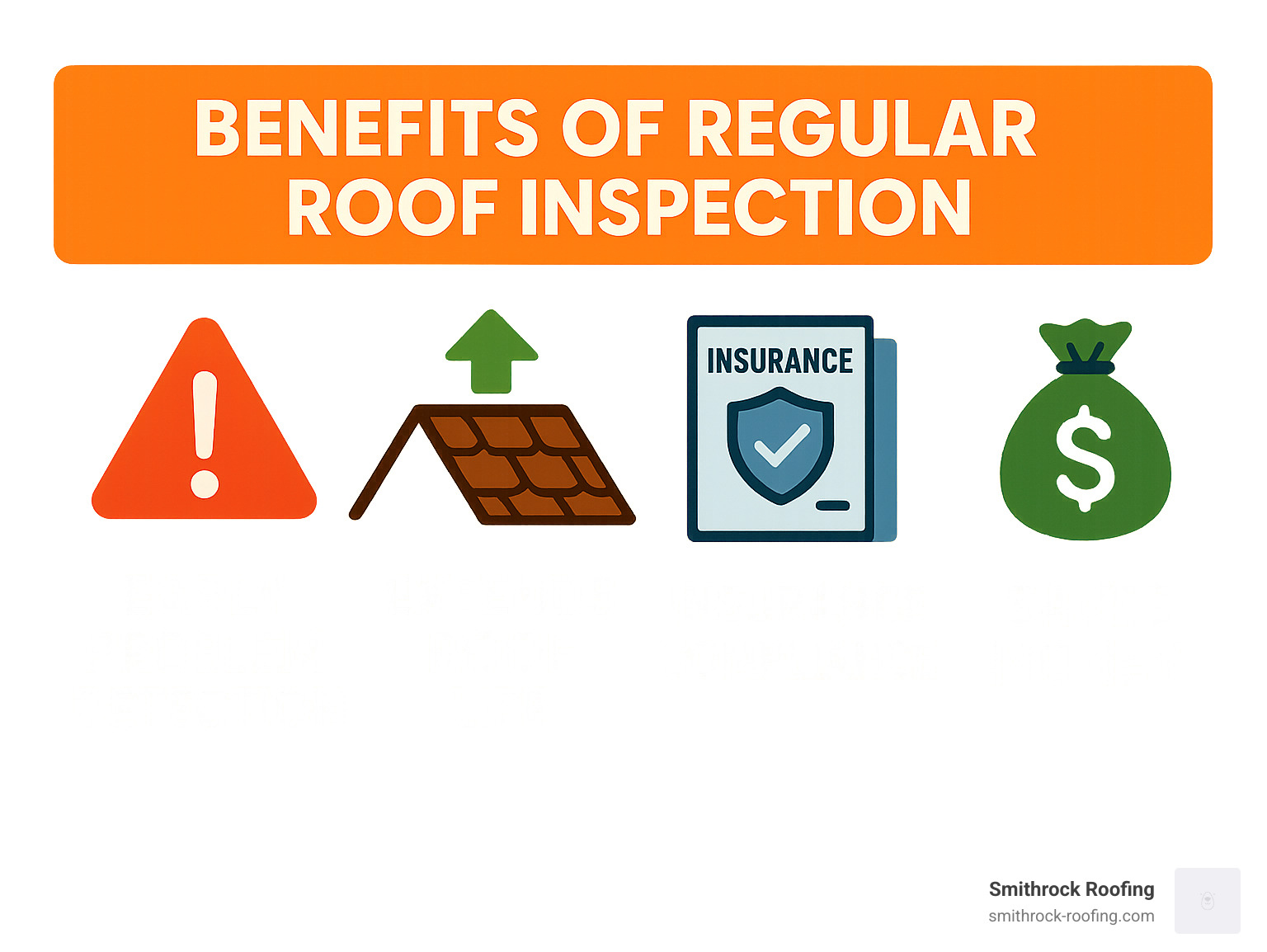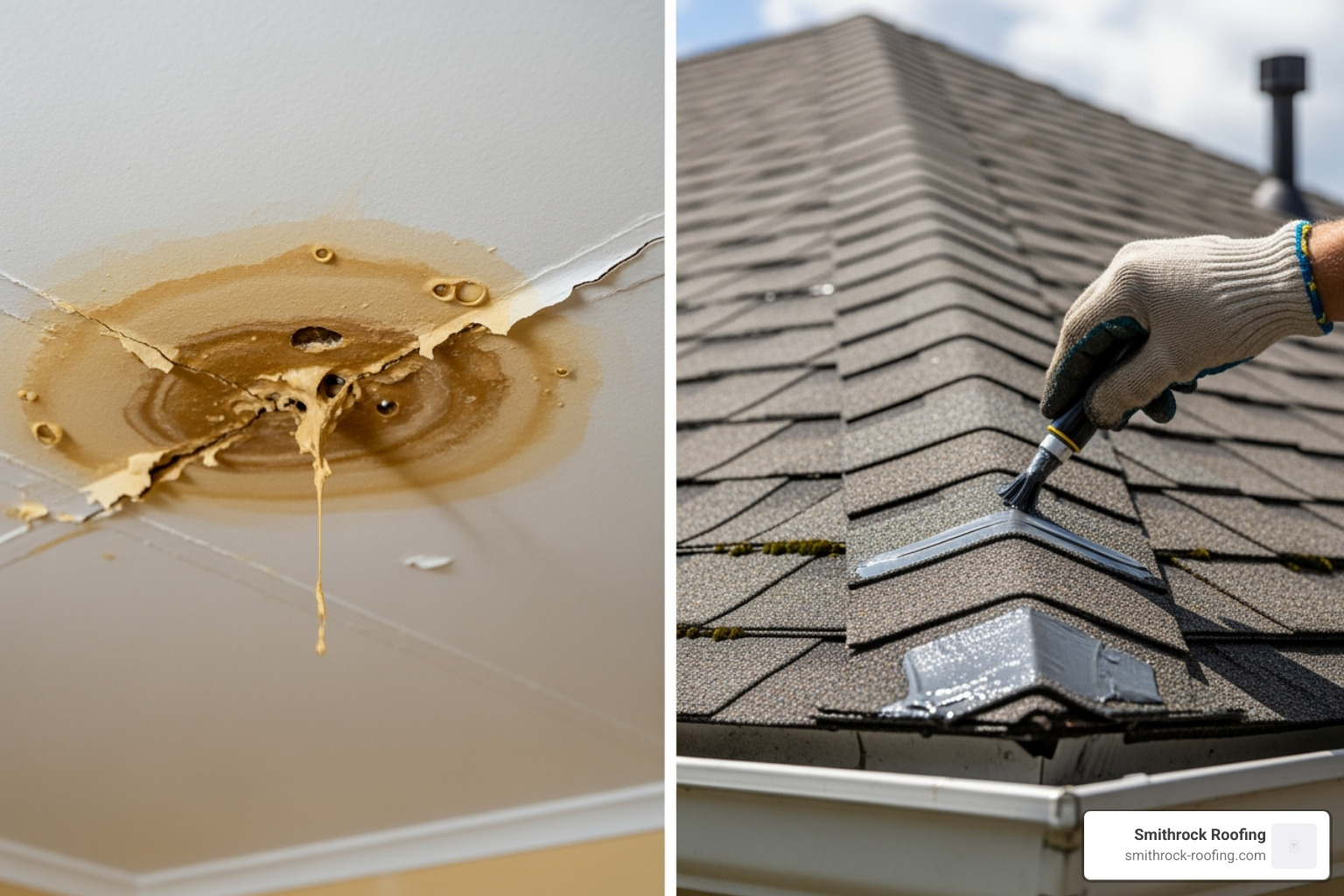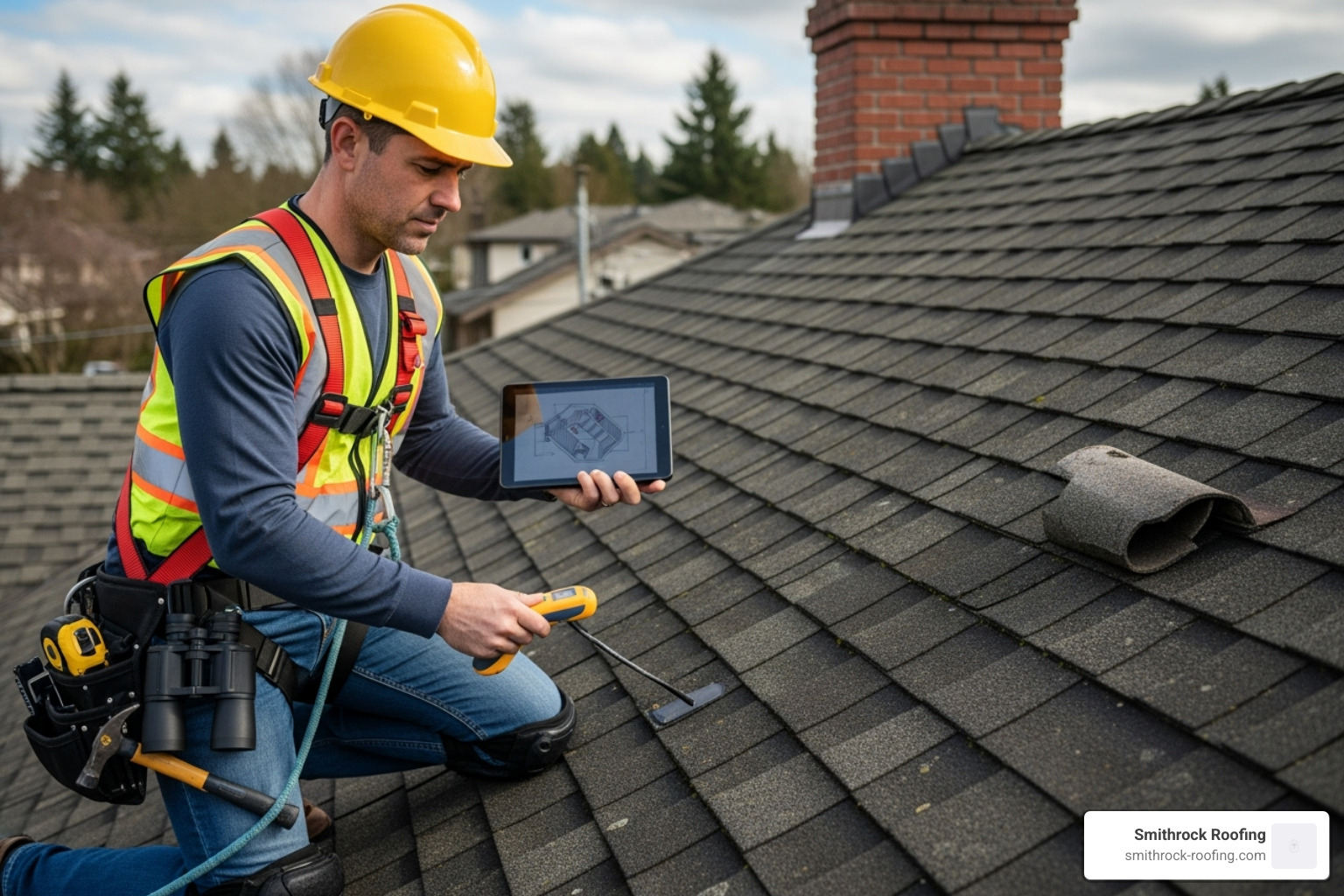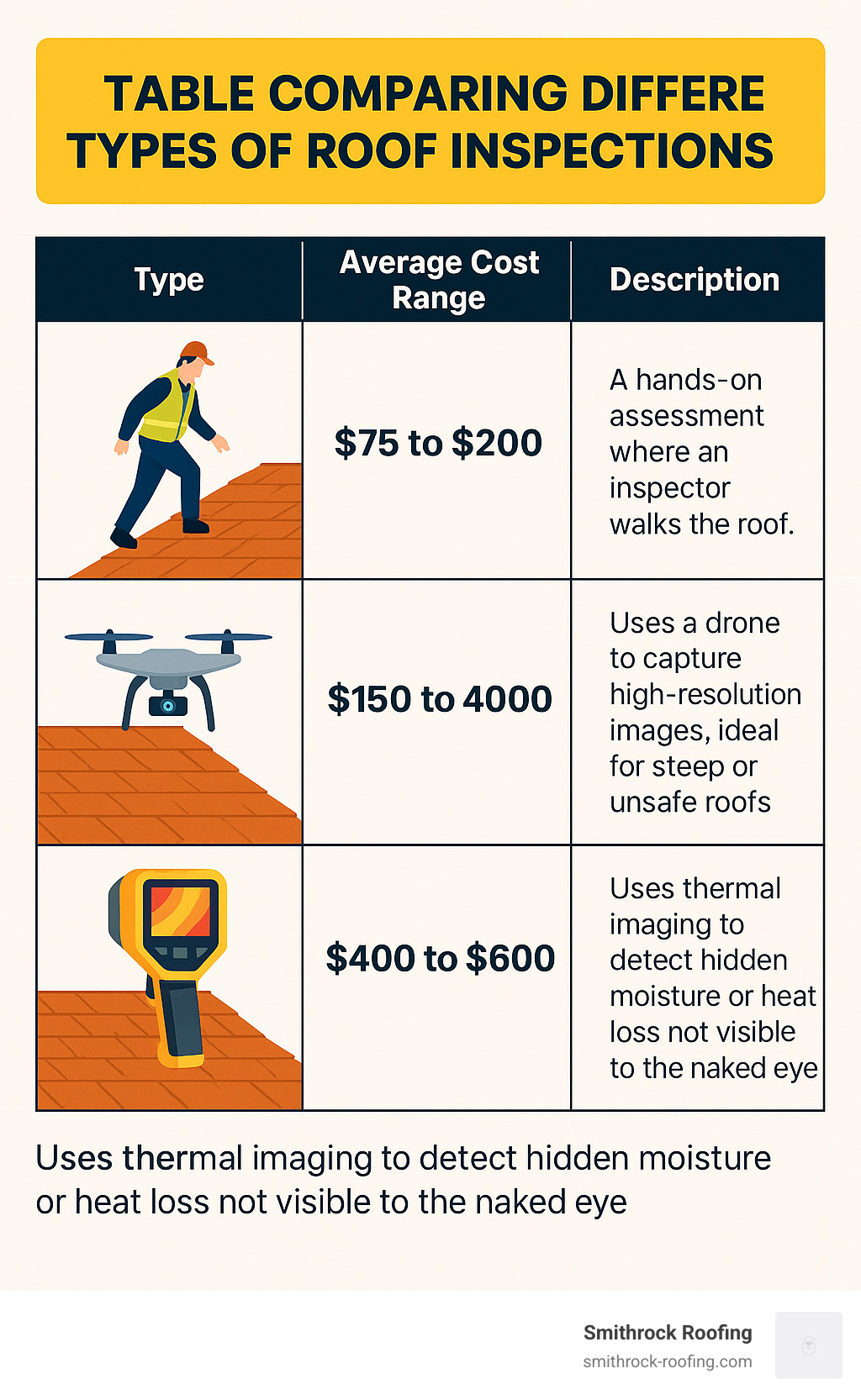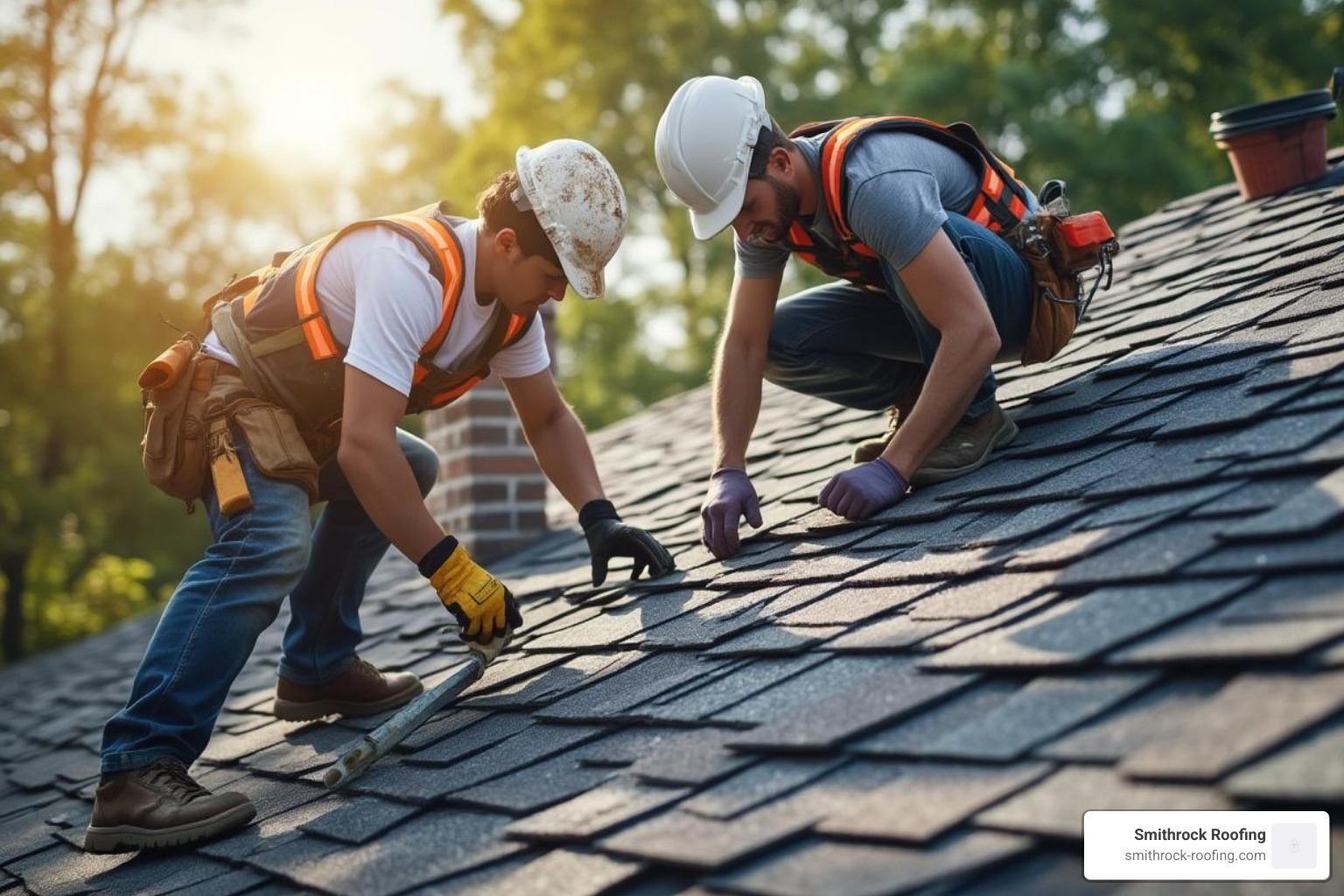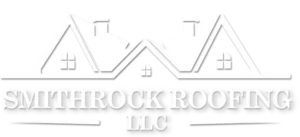Roof Inspection: Start Smart in 1 Hour
Why Your Roof Deserves a Regular Check-Up
A roof inspection is a professional assessment of your roof’s current condition, designed to spot hidden problems before they become costly emergencies.
- What it is: A detailed check of your roof’s structural integrity, materials, and internal signs of damage.
- Purpose: To identify issues early, prevent leaks, and ensure your roof continues to protect your home.
- Average Cost: $125 to $350.
- Typical Time: 1 to 2 hours.
Your roof is your home’s primary shield against the elements. Ignoring small issues can quickly lead to expensive problems like water damage, mold, or structural failure. Being proactive about your roof’s health is one of the smartest investments you can make.
I’m Jordan Smith, founder of Smithrock Roofing. With over 15 years in exterior construction, my team and I provide honest, expert roof inspection services to identify and solve home issues, ensuring your most important asset is protected.

Must-know roof inspection terms:
What Is a Roof Inspection and Why Is It Crucial for Your Home?
Think of a roof inspection as your home’s annual physical exam. It’s not just about finding problems—it’s about catching them before they become wallet-draining disasters. A professional examines every component of your roofing system, from shingles and flashing to gutters and structural elements, to identify vulnerabilities before they threaten your home’s integrity and your family’s safety.
Your roof works 24/7 to protect you from scorching heat, pounding rain, and heavy snow. Regular inspections are your first line of defense against water damage. A small crack in a shingle is a simple repair, but if it goes unnoticed, it can lead to wood rot, mold, and expensive interior damage. The difference between a $200 fix and a $15,000 restoration often comes down to timely inspections.
A compromised roof can also hurt your energy efficiency, leading to higher utility bills. For those involved in real estate transactions, a specialized inspection provides peace of mind that a general home inspector might not offer. Furthermore, many insurance companies now require periodic roof assessments to maintain coverage, making the benefits of regular roof inspections a crucial part of protecting your investment.
The Top Reasons to Schedule an Inspection
While annual inspections are wise, certain situations make them essential. Knowing when to call for professional help can save you thousands.
- Post-storm assessment: After a hailstorm, high winds, or heavy snow, get an immediate inspection. Hidden damage can lead to leaks, and waiting too long may jeopardize an insurance claim.
- Visible leaks or water stains: A water spot on your ceiling is a major red flag. By the time you see it, significant damage may have already occurred. Our roof leak prevention tips can help you spot signs early.
- Home transactions: When buying or selling, a dedicated roof inspection gives buyers confidence and prevents last-minute negotiation problems for sellers.
- Annual maintenance checks: These routine checks catch minor issues like loose granules or small cracks before they escalate into major problems.
- Aging roofs: Roofs over 10 years old need annual inspections, as cumulative wear and tear accelerates. Consider twice-yearly checks for roofs approaching 20 years.
- Moss or algae growth: This signals potential moisture issues. As our guide on ponding and vegetation on roof explains, these organisms can trap moisture and accelerate roof deterioration.
What a Roof Inspection Can Save You

The true value of a roof inspection is clear when you consider the alternative. Spending a few hundred dollars on an inspection can save you tens of thousands in emergency repairs.
- Minor Repairs ($300-$800): Catching loose shingles or worn flashing early is an affordable fix.
- Major Repairs ($5,000-$10,000+): When small issues are ignored, they can lead to rotted decking and other structural problems.
- Interior Damage ($$$$): Water can destroy ceilings, flooring, furniture, and personal belongings, adding thousands to your bill.
- Mold Remediation ($3,000-$10,000): Leaks create the perfect environment for mold, which poses serious health risks and requires costly professional removal.
- Structural Repairs ($30,000+): The most expensive consequence of neglect, where water compromises your home’s core structure.
Regular inspections also help preserve your roofing warranty, as most manufacturers require documented maintenance. A well-maintained roof protects your property value, keeps energy costs down, and provides peace of mind.
The Anatomy of a Professional Roof Inspection

A professional roof inspection is a comprehensive assessment, not a quick glance. Our certified inspectors carefully document their findings with photos and detailed notes, ensuring nothing is missed. We examine four critical areas: the exterior materials, structural integrity, interior conditions, and overall workmanship. Together, these elements paint a complete picture of your roof’s health.
Exterior and Material Inspection
When conditions permit, our professionals conduct a hands-on examination of your roof’s exterior. This up-close view is critical for spotting problems that are invisible from the ground.
- Shingle Condition: We look for curling, where the edges of the shingle lift up, making them vulnerable to wind uplift; cracking, which can be caused by thermal shock or age; blistering, which looks like bubbles on the shingle surface and signals trapped moisture; or completely missing shingles that leave the underlayment exposed. We also check for excessive granule loss in the gutters—these sand-like particles are your shingles’ primary defense against UV radiation, and their absence indicates that the shingles are nearing the end of their functional life.
- Flashing Condition: The metal strips around chimneys, skylights, and vents, known as flashing, are common failure points because they seal transitions between the roof and other structures. We carefully inspect these areas for signs of rust, which compromises the metal’s integrity; gaps between the flashing and the roof; or dried, cracked, and failed sealant. Even a tiny breach in the flashing can allow significant water to enter your home’s structure.
- Vents, Pipes, and Skylights: We check the seals and boots around all roof penetrations, as these are potential weak spots for leaks. The rubber boots around plumbing vents can become brittle and crack over time, creating a direct path for water.
- Chimney Condition: We examine the chimney structure for cracks in the masonry or crown, loose mortar joints, and other signs of water intrusion. A damaged chimney can absorb water like a sponge, leading to deterioration from the inside out.
- Gutter System: We ensure gutters and downspouts are clear of debris, properly aligned with the correct slope, and securely fastened. Clogged or misaligned gutters can cause water to back up under the shingles or overflow and saturate the ground near your foundation, leading to serious damage.
- Fascia and Soffit: We check the roof’s edges for rot, water damage, or pest intrusion. Damaged soffits can also be a sign of poor attic ventilation, which can contribute to a host of other roofing problems.
- Workmanship: We look for issues like exposed nails, which can rust and create leaks, or improper shingle overhang that can allow water to run down the fascia boards. Poor workmanship not only leads to premature failure but can also void your manufacturer’s warranty.
Structural and Interior Inspection
The attic and interior spaces often reveal hidden problems. This part of the inspection tells us what’s happening beneath the surface.
- Attic Examination: We look for signs of daylight penetrating the roof, which indicates holes, and check for sagging decking between rafters. A sagging roof deck is a serious red flag for structural weakness, often caused by prolonged moisture exposure that has rotted the wood.
- Proper Ventilation: An improperly ventilated attic traps heat and moisture, which can shorten your roof’s lifespan, increase energy bills by overworking your HVAC system, and lead to mold growth. We check for clear intake and exhaust vents to ensure a balanced airflow.
- Signs of Water Intrusion: We carefully search for water stains on ceilings and walls, wet or compressed insulation (which loses its R-value), and any signs of mold or mildew. Mold can pose significant health risks and indicates a persistent moisture problem.
- Structural Integrity: We inspect the roof decking, rafters, and trusses for wood rot, water damage, or other deterioration. A sagging roofline visible from the outside points to serious, widespread structural issues that require immediate attention.
- Pest Intrusion: Evidence of pests, such as droppings or nests, can reveal small openings in your roof that also allow moisture to enter. Rodents and insects can cause significant damage to insulation and wiring.
DIY vs. Professional Roof Inspection: A Safety and Accuracy Comparison
While the DIY spirit is admirable, a professional roof inspection is a safer and more accurate choice.
- Safety First: Walking on a roof is inherently dangerous without proper training, safety harnesses, and equipment. Falls can cause serious injury or death. Homeowners can perform ground-level checks with binoculars to spot obvious issues like missing shingles, but should leave on-roof work to certified professionals.
- Limitations of DIY: The untrained eye can easily miss subtle but critical warning signs of roof damage. A professional knows the difference between normal wear and a developing problem, such as distinguishing between hail damage and simple blistering, which can be crucial for an insurance claim.
- Professional Expertise: We use specialized tools like infrared sensors to detect hidden moisture and have in-depth knowledge of local building codes and manufacturer installation specifications. This level of detail is something a general home inspector might even miss, as their focus is much broader.
- Liability and Honesty: A professional report from a reputable roofer carries weight with insurance companies and in real estate transactions. Be wary of “free inspections,” which are often just sales pitches in disguise. At Smithrock Roofing, we provide unbiased, paid inspections that give you the honest, actionable information you need. For more on professional standards, see this comprehensive guide.
Scheduling Your Inspection: Timing, Frequency, and Cost
Proactive scheduling of your roof inspection is key to protecting your home and preventing major issues. Most inspections take between one and four hours, depending on your home’s size and complexity—a small time investment that can save you weeks of headaches and thousands of dollars down the road.
How Often Should You Get a Roof Inspection?
Follow these general guidelines to keep your roof in top condition:
- General Rule: Schedule a professional inspection at least once a year.
- Older Roofs (10+ years): Increase the frequency to twice a year, as materials begin to show their age and are more susceptible to damage.
- After Severe Weather: Always get an inspection after a major storm. Hidden damage from hail or high winds is common and can lead to serious problems if not addressed.
- Regional Climate: In North Carolina, preparing for hurricane season and winter ice storms with a timely inspection is a smart, preventative measure.
The Best Time of Year for an Inspection
While we can perform inspections year-round, certain seasons are ideal.
Spring and fall offer the best conditions for a thorough assessment. A spring inspection allows us to check for any damage caused by winter ice and snow before the summer storm season arrives. A fall inspection helps prepare your roof for the harsh winter months ahead, allowing time for any necessary repairs.
Mild weather is not just for comfort; it ensures a more accurate and safe inspection. Extreme heat can make shingles unsafe to walk on, while ice can hide damage. During these shoulder seasons, contractor availability is often better, meaning we can get to your inspection and any subsequent repairs more quickly.
Understanding the Cost of a Professional Roof Inspection
A professional roof inspection typically costs between $125 and $350. This investment can save you thousands in future repairs.
- Physical Inspection ($75 – $200): A hands-on, on-roof assessment.
- Drone Inspection ($150 – $400): Uses high-resolution cameras for steep or unsafe roofs.
- Infrared Inspection ($400 – $600): Uses thermal imaging to detect hidden moisture or heat loss.

Factors that influence the final cost include roof size, pitch (steepness), material, and accessibility. It’s also important to distinguish between a paid, comprehensive inspection and a free estimate. While we offer free roof estimates for specific repair or replacement projects, a paid inspection is an unbiased, detailed evaluation of your entire roof’s condition. Be cautious of companies pushing \”free inspections,\” as they are often sales tools designed to sell you unnecessary work.
After the Inspection: Interpreting Results and Choosing a Pro
Your roof inspection report is a roadmap for your roof’s health. Understanding it is the first step toward making smart, informed decisions about repairs, replacement, and even insurance claims. This is where you turn information into action to keep your home protected.
How to Read Your Inspection Report
A good report should be clear and comprehensive. Here’s what to look for:
- Detailed Written Analysis: A summary of your roof’s overall condition, highlighting any areas of concern in straightforward language.
- Photographic Evidence: High-quality photos that show you exactly what the inspector saw, providing clear proof of any damage.
- Summary of Findings: A clear list of identified issues and the recommended actions to address them.
- Urgency of Repairs: The report should distinguish between problems that need immediate attention (like an active leak) and those that can be monitored.
- Estimated Remaining Lifespan: A professional estimate of how many more years your roof has, which is invaluable for long-term budgeting.
- Specific Repair Recommendations: Details on exactly what needs to be fixed and how, as outlined in professional guides like this one on specific repairs.
- Clarifying Questions: Don’t hesitate to ask your inspector to explain anything you don’t understand. A good professional wants you to be fully informed.
Choosing a Reputable and Unbiased Inspector
Choosing the right professional is critical. The roofing industry has its share of \”storm chasers,\” so it’s important to do your homework.
- Check for License and Insurance: Never work with a contractor who can’t provide proof of both. This protects you from liability and ensures they meet professional standards.
- Look for a Local Reputation: Ask for recommendations and check online reviews on Google or the Better Business Bureau. We are proud of our reputation in communities like King, Clemmons, and High Point.
- Ask for References: A reputable company will gladly provide references from previous clients.
- Avoid Storm Chasers: Be wary of out-of-town contractors who appear after a storm, use high-pressure tactics, and demand upfront payment.
- Choose a Roofing Specialist: A general home inspector provides a broad overview, but a dedicated roofing specialist has in-depth knowledge of materials, installation, and failure points. Look for certifications from bodies like the NRCIA or InterNACHI.
- Get Multiple Quotes: For any significant work, get at least three quotes. Compare the scope of work, materials, and warranty—not just the price.
What Happens Next: Repairs, Replacement, and Insurance

Once you have your report and have chosen a contractor, it’s time to act.
If your inspection found only minor issues, our roof repair services can address them quickly, preventing them from becoming bigger problems. If the damage is extensive or your roof is near the end of its life, a full replacement may be the most cost-effective long-term solution. Our guide on roof repair vs. replacement can help you decide.
If the damage was caused by a storm, you may be able to file an insurance claim. Contact your insurance provider to start the process. It’s highly beneficial to have your trusted contractor present during the adjuster’s visit to ensure all damage is properly documented. Our team is experienced with storm damage roof repair and can help you steer the claims process.
Generally, insurance will not cover the cost of a routine maintenance inspection. However, if your insurer requires an inspection, they will often cover the cost. Either way, the small expense is a wise investment in your home’s long-term health.
Frequently Asked Questions about Roof Inspections
Homeowners often have similar questions about roof inspections. Here are answers to the most common ones we hear at Smithrock Roofing.
What are the different types of roof inspections?
There are three main types, each suited for different situations:
- Physical Inspection: A hands-on assessment where an inspector walks the roof. This is the most thorough method for identifying subtle issues, but it requires a roof that is safe to walk on.
- Drone Inspection: Uses a high-resolution drone to capture detailed images. This is ideal for roofs that are too steep, high, or potentially unsafe to walk on.
- Infrared Inspection: Uses thermal imaging to detect temperature differences that can indicate hidden moisture, air leaks, or missing insulation that are invisible to the naked eye.
What are the most common red flags an inspector looks for?
During a roof inspection, we focus on key warning signs that indicate current or future problems. These include:
- Missing, cracked, or curling shingles.
- Excessive amounts of shingle granules in the gutters.
- Damaged or corroded flashing around chimneys, vents, and skylights.
- Signs of water damage, such as stains on interior ceilings or walls.
- Any sagging or unevenness in the roof structure.
Does a standard home inspection cover the roof adequately?
While a home inspection includes a visual check of the roof, it is often not as thorough as an assessment by a dedicated roofing specialist. A general home inspector examines the entire property and may not have the specialized knowledge to identify subtle roofing issues or accurately predict a roof’s remaining lifespan.
A dedicated roof inspection from a professional roofer provides a much deeper analysis of materials, installation quality, and potential failure points. For a major investment like a home, this specialized report offers critical information and greater peace of mind.
Conclusion: Your First Step Towards a Secure Roof
We’ve covered what a roof inspection is, why it’s critical, when to get one, and what to do with the results. The most important takeaway is this: proactive roof care is one of the smartest investments you can make as a homeowner. It’s about protecting your property, keeping your family safe, and ensuring your peace of mind.
Your roof is your home’s first line of defense. A small, ignored issue can quickly escalate into a costly emergency. A professional roof inspection provides a clear roadmap, helping you catch problems early when they are easy and affordable to fix.
Here at Smithrock Roofing, we are your neighbors, committed to serving our communities across North Carolina, from Pfafftown to Rural Hall, with honest advice and top-quality service. Just as we recommend seasonal window checks, we believe regular roof inspections are the best way to ensure your most important asset remains healthy and strong for years to come.
Don’t wait for a leak to tell you it’s time for a check-up. Be proactive and invest in a secure future for your home.
Ready to gain that peace of mind? We’re here to help.
Contact Us for Your Professional Roofing Assessment
